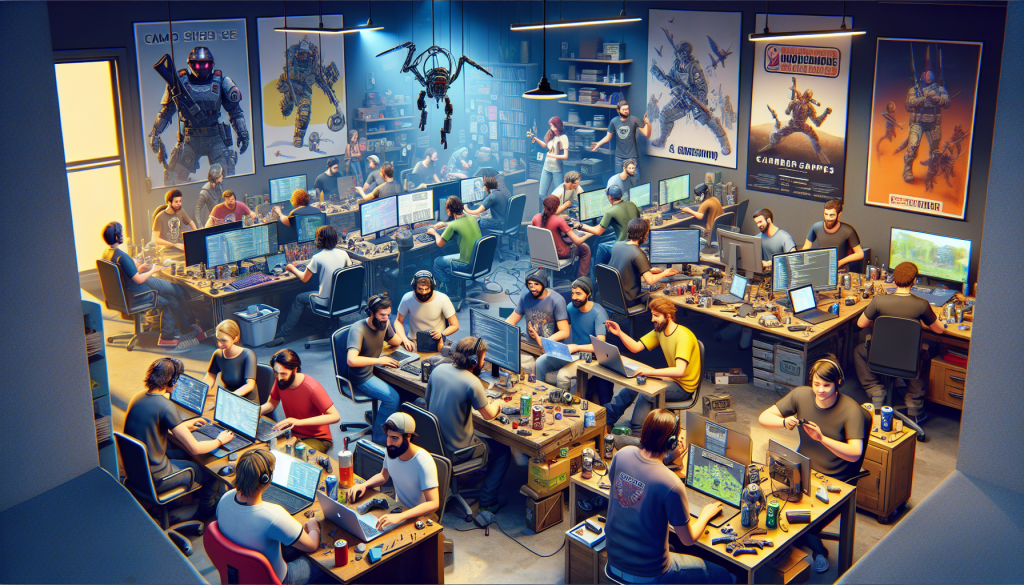The Impact of Cinematography in Video Games
The world of video games has come a long way since the days of Pong and Space Invaders. The industry has evolved into a multi-billion dollar enterprise, with millions of people around the globe logging in to play their favorite games daily. One of the key aspects that has significantly contributed to this immense success is the power of cinematography. But what exactly is the impact of cinematography in video games?
Put simply, cinematography enhances the overall gaming experience. It creates an immersive world that goes beyond mere gameplay, enticing players to lose themselves in beautifully designed landscapes and intricately detailed characters. And while the gameplay itself is the backbone of any game, it’s the cinematography that often makes a game stand out.
Cinematography: Adding Depth to Virtual Worlds
Without a doubt, one of the most significant impacts of cinematography in video games has been in its ability to create richly detailed, immersive worlds which captivate players and keep them coming back for more.
- Visual Appeal: The use of cinematography in video games enhances their visual appeal. It creates stunning visuals that pull players in, encouraging them to explore every corner of the game world. From breathtaking cityscapes in games like Grand Theft Auto V to the lush environments in The Legend of Zelda: Breath of the Wild, cinematography helps bring these virtual worlds to life.
- Storytelling: Cinematography also plays a crucial role in video game storytelling. It helps set the mood and tone of the game, building tension, excitement, or fear as required. It also helps in character development, creating compelling protagonists and antagonists that players can connect with.
- Interactivity: Lastly, cinematography in video games enhances interactivity. By creating a more realistic and engaging environment, players feel more connected to the game world. This deep immersion often leads to a heightened sense of enjoyment and satisfaction.
Game-Changing Cinematography
Advancements in technology have led to more sophisticated cinematography techniques being employed in video games. This has paved the way for games that are not only thrilling to play but are also aesthetically pleasing to look at.
A standout example is Red Dead Redemption 2. With its detailed animation, compelling character designs, and breathtaking landscapes, the game is a testament to the power of cinematography. It successfully transports players to a bygone era, allowing them to experience life as a cowboy in the American West.
Overall, the impact of cinematography in video games is profound. It has transformed games from simple pastimes into immersive experiences that captivate players’ imaginations and keep them engaged for hours on end. And as technology continues to evolve, the role of cinematography in video games is set to become even more significant.
Understanding Visual Artistry in Gaming: Techniques and Tools
Have you ever been so taken by the beautifully crafted landscapes in your favorite video game that you almost forget to play the game itself? Yes, that’s the power of visual artistry in gaming. And guess what? That’s all down to some clever cinematography! Now, you might think, “Wait, isn’t cinematography just about movies?” Well, not quite. Cinematography has a big role in the video game industry too! Let’s dive right in and learn more about the techniques and tools that make our virtual adventures so visually stunning.The Magic of Lighting
First off, let’s talk about lighting. Just like in movies, lighting in video games can set the mood, guide the player’s attention, and create a sense of realism. Developers use techniques like dynamic lighting, where the lighting changes based on the time of day in the game, or shadow mapping, which helps create realistic shadows. Ambient occlusion, a technique that simulates the way light radiates in real life, especially off what are normally considered non-reflective surfaces, is another tool that makes the gaming environment feel more realistic.The Power of Camera Angles
Another key element of visual artistry in gaming is the use of camera angles. Ever noticed how the camera angle changes in a game to focus on a significant event or character? That’s no accident – that’s cinematography at work! Developers use techniques like the first-person perspective, where the game is viewed from the character’s point of view, or the third-person perspective, where the camera is positioned behind the character. Cinematic camera angles, used in cutscenes or scripted events, give game developers the power to direct the player’s attention exactly where they want it.Color Grading: Painting Emotions
Finally, let’s talk about color grading. You might not notice it outright, but the colors in a video game are rarely coincidental. They’re carefully chosen and adjusted to evoke specific emotions and reactions. Developers use techniques like color correction to ensure the colors in the gaming environment look as they should, and color grading to enhance the visual narrative of the game. A warm color palette might be used to evoke feelings of comfort and safety, while a colder one could be used to create a sense of detachment or danger. So, next time you’re playing your favorite video game, take a moment to appreciate the visual artistry at work. It’s these little details – the lighting, the camera angles, the colors – that make our gaming experiences truly immersive and memorable. Now that’s the power of cinematography in gaming!The Role of Cinematography in Enhancing Gaming Experiences
As a gaming enthusiast, you’ve probably experienced those mesmerizing moments when a game’s visual representation leaves you awe-struck. That’s the magic of cinematography at work in video games! Today, we’ll be diving deep into this fascinating aspect and its role in boosting your gaming experiences.
Immersive Storytelling through Cinematography
Remember that moment in The Last of Us Part II when Ellie and Dina dance in the abandoned library? The heartwarming intimacy was conveyed not just through dialogue, but also through the clever use of lighting, camera angles, and shot composition. This sort of immersive storytelling is the goal of cinematic techniques in video games.
- Lighting: It sets the mood and directs the player’s attention to important elements.
- Camera Angles: They shape the player’s perspective and emotional response.
- Shot Composition: It can be used to emphasize certain elements or create a sense of scale.
Creating a Unique Visual Style
Each game has its own unique visual style, and cinematography plays a key role in defining this. Think of the stark contrast between the somber and gritty visuals of Bloodborne and the colorful and vibrant aesthetics of Super Mario Odyssey. Cinematography techniques like color grading, camera movement, and choice of lens help establish a game’s unique visual identity.
Enhancing Gameplay with Cinematography
Far from being just about aesthetics, great cinematography can also enhance the gameplay itself. For instance, clever camera positioning can create tension in horror games, while dynamic camera movements can make action sequences feel more thrilling. By guiding the player’s gaze, cinematography can also help highlight important gameplay elements.
In short, cinematography offers a powerful toolkit for game designers to craft memorable and engaging experiences. So, next time you find yourself getting lost in a game’s world, spare a thought for the artistry behind it!
Appreciating the Art of Cinematography in Video Game Design
Whether you’re an avid gamer or simply an observer, there’s no denying that the art of cinematography plays a crucial role in shaping video game design. It’s like the secret ingredient that takes the gaming experience from being just good to utterly captivating. But what exactly does it entail? Let’s dive in and explore this fascinating world!
The Magic of Visual Storytelling
At its core, cinematography is visual storytelling. In movies, it’s the way the scene is shot, the lighting, the camera angles, and so much more. When it comes to video games, these elements are just as crucial. They guide the player through the narrative, draw attention to key details, and create an atmosphere that immerses the player in the virtual world.
Cinematography: The Unsung Hero
Often, the art of cinematography in video games is an unsung hero. It’s not something players always actively notice, but it’s always there, subtly influencing their experience. Think of those breathtaking landscapes in Red Dead Redemption 2 or the eerie, moody lighting of Resident Evil. The way these elements are captured and presented can make or break the overall game experience.
It’s All in the Details
From sweeping shots of vast, virtual landscapes to the tiniest details in a character’s costume, cinematography works its magic in all aspects of a video game. In fact, the best games are those where the developers have paid just as much attention to the small moments as the grand ones. It’s about creating a living, breathing world that players can lose themselves in, and that’s a truly magical thing.
Looking at the Bigger Picture
When we talk about appreciating the art of cinematography, it’s important to look at the bigger picture. Yes, it’s about the visuals and the aesthetics, but it’s also about how those serve the story and the gameplay. When all those elements come together seamlessly, you’re left with a game that’s not just visually stunning, but also deeply engaging and satisfying to play.
Celebrating Cinematic Video Games
As gamers, it’s important for us to acknowledge and appreciate the role cinematography plays in our favourite titles. So next time you pick up the controller, take a moment to really look at the game you’re playing. Notice the camera angles, the lighting, the composition of the shots. Celebrate the artistry and effort that has gone into creating that world. Because it’s this cinematography that takes us beyond the screen and into the heart of the story.












